A selection from the TFAM's permanent collection offers a look at Taiwan's art over the last centuryTwo terrific shows currently running in Taipei sum up the 20th century in very different fashions. The first at Taipei Fine Arts Museum (TFAM) is an attempt to write Taiwan's art history, not in print, but in 117 master paintings from the institute's permanent collection. The second show is at Dimensions Art Center, where an assortment of 25 works showcase the diverse culture of Taiwan's contemporary art scene at the end of the last century.
TFAM's retrospective show, called "Highlights from the Permanent Collection," looks back at 100 years of art in Taiwan, covering ground-breaking material such as Huang Tu-shui's (
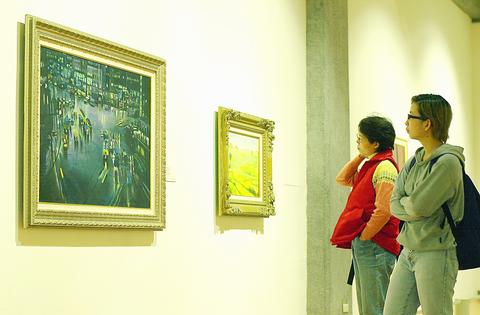
PHOTO: CHEN CHENG-CHANG, TAIPEI TIMES
The exhibition is spread out over two floors of the museum, with eight halls on the second floor separated according to decade. Highlights of the show include masterpieces such as Liao Chi-chun's (
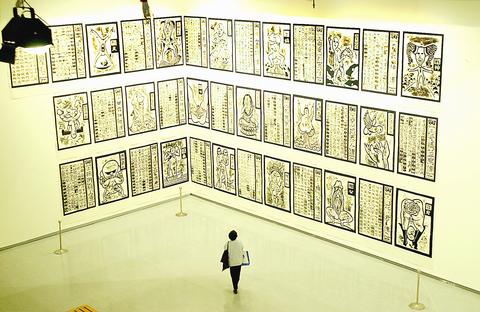
PHOTO: CHEN CHENG-CHANG, TAIPEI TIMES
Most of the first floor artwork takes an angst-ridden look at society, challenging social norms and values through mixed media presentations that range from video installations to computer-aided print outs. Yao, for example, humorously touches upon the issue of the tense relationship across the Taiwan Strait, while Hung, centers his themes around Japanese comic characters that are the only company of many children of working parents. Provocative woodcuts by Hou Chun-ming's (侯俊明) and Huang Chih-yang's (黃志陽) Space Series (1992), which feature scrolls with images of beast-like humans, touch on taboos such as sex and morality. Touching on the issue of the media and society, Wang Jun-jien's (王俊傑) multimedia installation uses repeated images to issue a scathing critique of crass contemporary commercialism.
For your information
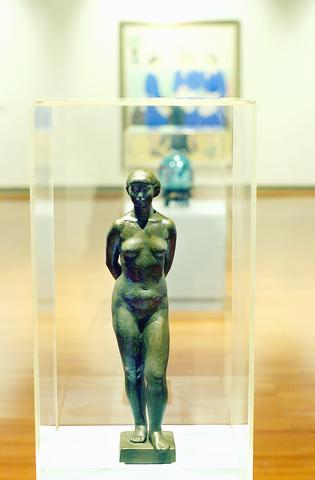
PHOTO: CHEN CHENG-CHANG, TAIPEI TIMES
What: Highlights from the Permanent Collection

PHOTO: CHEN CHENG-CHANG, TIAIPEI TIMES
Where: Taipei fine arts museum, 181 Chung-shan N. Rd., Sec. 3, Taipei (台北美術館,台北市181中山北路3段)
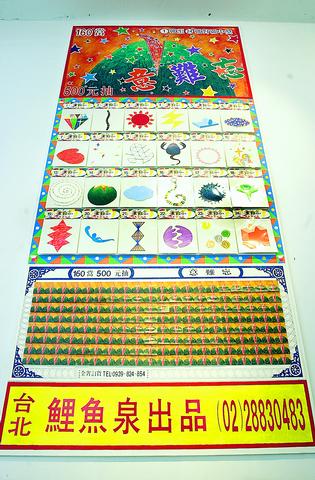
PHOTO: CHEN CHENG-CHANG, TAIPEI TIMES
When: First floor until March 25, second floor until July 8
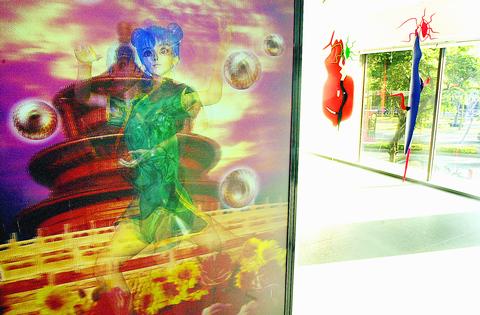
PHOTO: CHEN CHENG-CHANG, TAIPEI TIMES
At Dimensions Art Center, modern artists take a jaded look at the 20th century
"Passion for the Good Old Days" at Dimensions Art Center, with its 25 pieces, offers a sort of off-Broadway contrast to TFAM's retrospective exhibition.
This irreverent contemporary art show says goodbye to the 20th century by being fun and dynamic, and reminds one of the recently-closed Taipei Biennial at TFAM. Drawing from a variety of sources, this lively show displays the cultural mix evident in Taiwan's contemporary art. The only overlap with TFAM's Highlight show is a mixed-media installation depicting Japanese comic book characters by Hung Dung-lu (洪東祿).
The eight featured artists, each with their unique and idiosyncratic style, are placed under two categories: passion for childhood and passion of self. Some of the self-portraits are highly personal, sometimes verging on narcissistic, while others make sarcastic critiques of society and people.
Installation artist Hung Yi's (洪易) has created four-layered acrylic boxes, one of which is a model of a teahouse with the facade of a police station, suggesting that policemen prefer to sip tea, rather than patrol the streets.
Peng Hung-chih (彭弘智), another installation artist, made a dog sculpture which requires the viewer to kneel and look into its eyes. Inside the dog one sees a video of oneself as a dog eating dog food. At this point, the viewer recognizes the significance of the sound of a dog eating which is piped incessantly through the gallery's sound system.
Lee Yi-chuan (李宜全), a contemporary artist who recently returned from a two-month stay at the OMI art village in New York, made an enlarged board game which portrays commercialism and gambling as pervasive elements of our lives.
For your information
What: Passion For The Good Old Days
Where: Dimensions Art Center (帝門藝術中心), 2F, 341, Sec. 4, Jen Ai Rd., Taipei (臺北市仁愛路四段341號2樓)
When: Until Feb. 28

Exceptions to the rule are sometimes revealing. For a brief few years, there was an emerging ideological split between the Democratic Progressive Party (DPP) and Chinese Nationalist Party (KMT) that appeared to be pushing the DPP in a direction that would be considered more liberal, and the KMT more conservative. In the previous column, “The KMT-DPP’s bureaucrat-led developmental state” (Dec. 11, page 12), we examined how Taiwan’s democratic system developed, and how both the two main parties largely accepted a similar consensus on how Taiwan should be run domestically and did not split along the left-right lines more familiar in

As I finally slid into the warm embrace of the hot, clifftop pool, it was a serene moment of reflection. The sound of the river reflected off the cave walls, the white of our camping lights reflected off the dark, shimmering surface of the water, and I reflected on how fortunate I was to be here. After all, the beautiful walk through narrow canyons that had brought us here had been inaccessible for five years — and will be again soon. The day had started at the Huisun Forest Area (惠蓀林場), at the end of Nantou County Route 80, north and east

Specialty sandwiches loaded with the contents of an entire charcuterie board, overflowing with sauces, creams and all manner of creative add-ons, is perhaps one of the biggest global food trends of this year. From London to New York, lines form down the block for mortadella, burrata, pistachio and more stuffed between slices of fresh sourdough, rye or focaccia. To try the trend in Taipei, Munchies Mafia is for sure the spot — could this be the best sandwich in town? Carlos from Spain and Sergio from Mexico opened this spot just seven months ago. The two met working in the

This month the government ordered a one-year block of Xiaohongshu (小紅書) or Rednote, a Chinese social media platform with more than 3 million users in Taiwan. The government pointed to widespread fraud activity on the platform, along with cybersecurity failures. Officials said that they had reached out to the company and asked it to change. However, they received no response. The pro-China parties, the Chinese Nationalist Party (KMT) and Taiwan People’s Party (TPP), immediately swung into action, denouncing the ban as an attack on free speech. This “free speech” claim was then echoed by the People’s Republic of China (PRC),